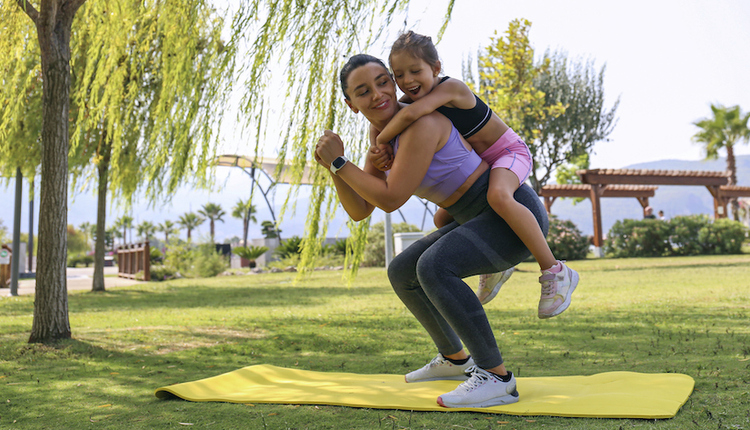
The future of fitness is trending toward an online presence. Personalized technology for tracking fitness progress is replacing gym scales; functional fitness and bodyweight workouts trump fancy equipment; home gyms enable quick home workouts; there is easier access to high-level trainers and programs via social media; and now, the concern over the spread of COVID-19 in a large gym setting.
Trainers are scrambling to get their in-person fitness programs into a virtual setting as quickly as possible to accommodate the needs of their clients who are now working out at home, while also trying to keep their clients motivated to continue. As with the development of any new style of training, problems arise. There are several ways to address these problems, and the first is to let go of all expectations of how a home fitness program should go. At a gym, most clients and trainers get an uninterrupted, hour-long training session, with easily accessible equipment at their disposal. That is not the case in at-home workouts — children, spouses, animals, FedEx and phone calls are just a few of the common disruptions to the focus of the client. Not to mention, the piles of laundry and dirty dishes in the background are just begging to be done first. So as a trainer, encourage the client to let go of all expectations of how previous workouts were completed and set up a new reality for how workouts will go. Throw the all-or-nothing mentality out the door.
New Scheduling Strategies for Your Client: Encourage the client to realize that whatever he/she gets done in the workout program list is something to celebrate. Set aside specific time(s) in a day to work out, write it on the daily calendar or schedule for everyone to see. Program workouts into chunks of time in a day — encourage them to do 10 minutes here and 10 minutes there, checking off the list as they go. This creates a more doable approach and feeling of success by the client, therefore increasing program adherence.
Second, keep things simple. Keep workouts to a minimum use of equipment and space. Repeat common warm-ups and cooldowns over a week’s time. Keep workout templates and organization the same, day-to-day. At-home workouts are already distracting and chaotic, and simplicity and repetitiveness help a client complete the workouts in a quicker, less stressful manner. While also keeping programs simple, make them enjoyable. Program adherence is of utmost importance for a client’s success, and without the weekly face-to-face accountability, the trainer has to find new ways to keep the client on track. This is where it is important to revisit the client’s goals, interests and enjoyed modes of fitness to best suit the client.
Program Ideas for Client Retention: Give the client a new bodyweight skill to practice and master — skills such as handstands, jump roping, single leg squats, pull-ups, plank holds, running or jumping form, learn a new dance, etc. Third, coach clients via video, just like in person, but keep videos simple and reusable. At-home fitness goals are slightly different than at the gym for most clients, in that time is of the essence. To help yourself and your client, record all the “live” coaching, edit down and save the videos to an online format and re-use them. Not all clients will want “live virtual” training sessions. In fact, most will want digestible, visual and written forms of the workouts to take and follow on their own time. Therefore, save time and reuse as much as you can.
Recording Strategies for Ease of Use: Record videos horizontal using a phone and a tripod, for best visual clarity. Save workout demonstrations into playlists. For example, all of the warm-up strategies can be saved in one list, all of the dumbbell workouts saved into one list, same for resistance bands, HIIT circuits or any other workout templates coached. This makes it easier to find, distribute and reuse for multiple users. Add closed captions to all videos and provide written descriptions in the box below each video so the client can choose how he or she will follow the program. Loading all videos into one common online platform that all clients can be directed to makes it easier for access and also saves the trainer time. Fourth, create a virtual community for support and accountability. People still want connection with others, especially now, when everyone is staying home. Something about suffering together for a common goal and/or friendly competition creates an environment of trust, encouragement, vulnerability and growth.
Creating Connection/Interaction: Facilitate chat groups on messenger, group texts, or set up an online platform to host large group messaging or videos — this is a great way to incorporate connection. Ask questions, post comments, post videos of personal workout achievements, host live chats, create weekly challenges, etc. to keep people engaged and interacting. Lastly, keep office hours much like in a gym. Suddenly becoming accessible via message 24/7 can lead to system overload for the trainer, trying to accommodate every client’s needs, all day long. This will lead to burnout in the long run.
Strategies for the Long Game: Clearly communicate and state “office” hours when available to answer messages, coach client videos, provide training sessions and set up appointments. To help, shut off notifications when not in the office, so the tendency to continuously check messages and be available is lessened. This will help the client respect the time of the trainer, teach them to think for themselves and help them step back from emotional needs that may be driving them to constantly message the trainer for assurance.
The online world of fitness can provide a great additional income to in-person training, can be automated and reusable for ease of use and highly profitable, but it requires a different mindset and approach focused on simplicity and time-saving methods.


















